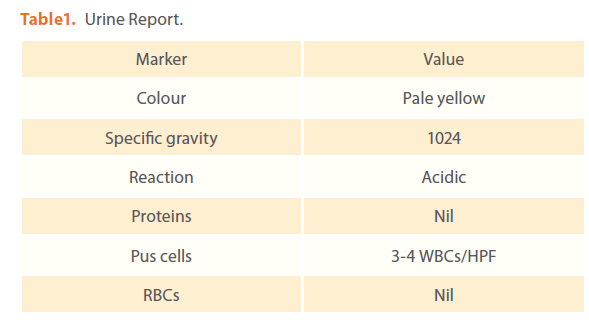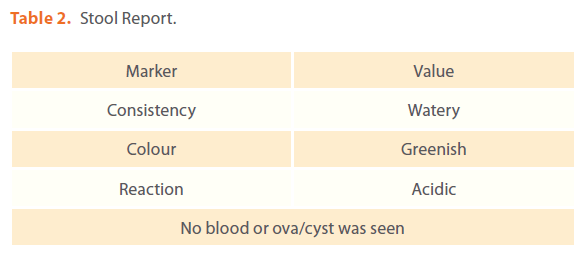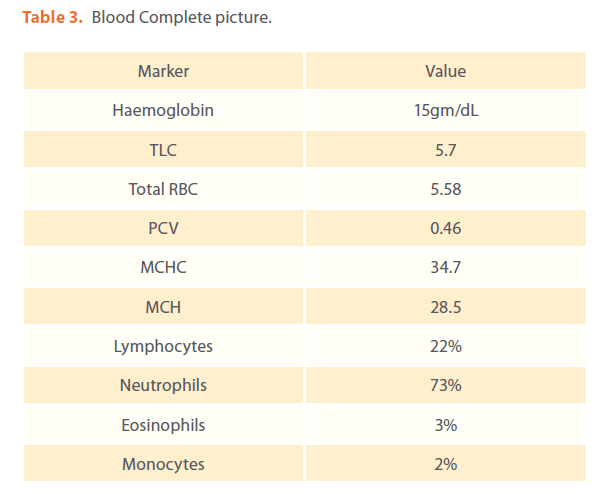Introduction
The genus Aeromonas include many species but the most common ones associated with human infections are Aeromonas veronii, Aeromons hydrophila, Aeromonas jandaei, Aeromonas caviae and Aeromonas schubertii [1]. The diseases caused by Aeromonas include gastroenteritis, ear and wound infections, cellulitis, urinary tract infections and septicemia [2]. We describe here a case of Aeromonas veronii biovar sobria gastroenteritis in a young patient. This is the first documented case reported from Pakistan. Involvement of Aeromonas species in diarrheal diseases and gastroenteritis has also been reported from other countries like Bangladesh, India, Finland and Japan [3-6]
Case report
A 21 years old man presented with one day history of loose watery stools, abdominal pain, vomiting and mild fever. There was no previous significant medical or surgical history. He reported consuming food and water from a local vendor prior to his illness. According to him, stools were watery in consistency up to 20 episodes per day. He also gave history of fever but it was not documented. The frequency of vomiting was 5-6 per day. On examination he was dehydrated and had coated tongue. His blood pressure was 90/50mmHg and his pulse rate was 88/minute. He was afebrile at that time. He was admitted in the hospital emergency unit. Initial thought was that he might be suffering from cholera. He was immediately rehydrated with Ringer’s lactate infusion (20drops/minute), and was given injection gravinate and Injection hyoscine stat. After initial rehydration management, his blood and stool samples were collected for laboratory investigation. He was shifted to the medical ward and was started on Inj. Ciprofloxacin 200mg twice daily, infusion Metronidazole 500mg three times a day, injection Maxolon 10 mg three times a day. He was rehydrated with infusion Normal saline 1000ml once daily. He was advised to take orally Oral Rehydration salt (ORS). His blood complete picture and urine routine examination was unremarkable except mildly raised neutrophil count in blood (73%) (Table 1,2,3). On gross examination, his stool sample was of green in colour, with watery consistency with mucus flecks. On Gram’s staining, gram negative rods were seen, with few epithelial cells. No pus cells were seen. Motility was performed by hanging drop method. Rapidly motile organisms were seen, resembling shooting star motility. The sample was inoculated on thiosulphate citrate bile salt sucrose agar (TCBS, Oxoid, UK), MacConkey’s agar (Oxoid, UK), deoxycholate citrate agar (DCA, Oxoid UK) and blood agar (Oxoid, UK). The plates were incubated at 370C for 24 hours. After incubation, yellow sucrose fermenting colonies were seen on TCBS agar. There were non-lactose fermenting colonies on DCA and MacConkey’s agar. There was clear hemolysis around the colonies on blood agar. The catalase and oxidase tests were performed, both were positive. It was first thought that the isolated organism was Vibrio cholerae. But to confirm the organism, API 20 E (Biomerieux) was used. Besides, esculin test and DNase test were also employed for the identification. After 24 hours of incubation, the organism identified was Aeromonas veronii biovar sobria, esculin test negative and DNase test positive. The organism was susceptible to ciprofloxacin, aztreonam, cefoperazone-sulbactam, piperacillin-tazobactam, gentamicin, amikacin and imipenem. It was resistant to tetracycline, cotrimoxazole and ampicillin. It was an unusual and uncommon organism isolated first time in our laboratory. The empirical treatment given to the patient was adequate, and the patient recovered.

Table 1. Urine Report.

Table 2. Stool Report.

Table 3. Blood Complete picture.
Discussion
Infections due to A. sobria are not an unusual presentation in hospitals worldwide. It results is extra-intestinal and diarrheal infections in human, the strains are often originated from water [7,8]. It frequently results in mild, self limited diarrheal illness, associated with nausea, vomiting and cramping abdominal pain. In this study, we have described the isolation of A. sobria for the first time in our laboratory. Various species of Aeromonas are associated with diarrhea, but A. sobria is most frequent species than the other species. In a study, Vila et al isolated Aeromonas spp. as the cause of traveler’s diarrhea in 18 out of 863 patients. Among these 18 cases, nine were caused by A. sobria [2]. These findings agree with the results of Hänninen et al. [3], who reported that A. sobria were the most common Aeromonas spp. associated with traveler’s diarrhea in tourists traveling to Morocco. Similarly, Yamada et al. [4] found that A. veronii biotype sobria was the Aeromonas species most frequently implicated as a cause of traveler’s diarrhea in Japanese travelers returning from unindustrialized countries. Regional data from India showed that A. sobria was involved in 1.8% of patients with diarrhea [9]. In our study, watery stools, fever, and abdominal cramps were the most common symptoms, which is consistent with other reports [3,10]. The A. sobria isolated in our study was resistant to ampicillin, tetracycline, and trimethoprim-sulfamethoxazole. A similar resistance pattern of A. sobria was also described in another study from Spain [2].
Conclusion
A. sobria is the Aeromonas species most frequently associated with watery diarrhea, fever, and abdominal cramps, sometimes mimicking the cholera infection. The persistence of symptoms makes the use of antimicrobial treatment necessary. Early clinical and laboratory measures should be taken for rapid diagnosis and prompt treatment.
190
References
- Janda JM, Abbott SL (1998) Evolving concepts regarding the genus Aeromonas: an expanding panorama of species, disease presentations and unanswered questions. Clin Infect Dis 27(2): 332-344.
- Vila J, Ruiz J, Gallardo F, Vargas M, Solar L, Figueras MJ, Gascon J (2003) AeromonasSpp and Traveler’s diarrhea: Clinical features and Antimicrobial resistance. Emerging Infectious Diseases 9(5): 552-555.
- Hanninen ML, Salmi S, Mattila L, Taipalinen R, Siitonen A (1995) Association of Aeromoans spp. with traveler’s diarrhea in Finland. J Med Microbiol 42(1): 26-31.
- Yamada S, Matsushita S, Dejsirilert S, Kudoh Y (1997) Incidence and clinical symtoms of Aeromonas associated traveler’s diarrhea in Tokyo. Epidemiol Infect 119(2): 121-126.
- Kuhn I, Albert MJ, Ansaruzzaman M, Bhuiyan NA, Alabi SA, Islam MS, et al. (1997) Characterization of Aeromonas spp. Isolated from human with diarrhea, from healthy controls and from surface water in Bangladesh. J ClinMicrobiol 35(2): 369-373.
- Albert MJ, Faruque AS, Faruque SM, Sack RB, Mahalanabis D (1999) Case control study of enteropathogens associated with childhood diarrhea in Dhaka, Bangladesh. J ClinMicrobiol 37(11): 3458-3464.
- Janda JM, Duffey PS (1988) Mesophilicaeromonads in human disease: current taxonomy, laboratory infection and infectious disease spectrum. Rev Infect Dis 10: 980-997.
- Altwegg M, Geiss HK (1989). Aeromonas as a human pathogen. CRC Crit Rev Microbiol 16: 253-286.
- Deodhar LP, Saraswathi K, Varudkar A (1991) Aeromonas spp. and their association with human diarrheal disease. J ClinMicrobiol 29:853–856.
- Albert MJ, Ansaruzzaman M, Talukder KA, Chopra AK, Kuhn I, Rahman M, et al. (2000) Prevalence of enterotoxin genes in Aeromonas spp. isolated from children with diarrhea, healthy controls, and the environment. J ClinMicrobiol 38: 3785–3790








